Midges in Scotland
The midges in Scotland may be tiny insects, but they have a big impact on locals, visitors and tourism in general. Particularly in the Scottish Highlands which is where they get the nickname of the Highland Midge.
There is also a Gaelic name for this teeny, tiny little midge 'Meanbhchuileag' which simply means 'tiny fly'.
Scottish midges are very, very small biting insects from the Ceratopogonidae group of flies.
Although research has found that there are almost forty different species of midge recorded in Scotland, the most common biting midge (which definitely describes this hated 'wee beastie' of Scotland) is specifically named 'Culcoides Impunctatus'.
In the US we sometimes call this type of tiny, flying insect a 'no-see-um' and the midges in Scotland fit this name pretty well because they're so small. However, midges do tend to 'work' in swarms and those are very visible indeed.
Although much smaller than mosquitoes, they pack a similar punch with their bite which is at best annoyingly itchy, and at worst red, swollen and intensely itchy!
- About midges in Scotland
- What are the worst places in Scotland for midges?
- Which areas in Scotland don't have midges?
- When is midge season in Scotland?
- What time of day are Scottish midges most active?
- What is the Scottish midge life cycle?
- What are midge bites like?
- How do I treat Scottish midge bites?
- What is the best Scottish midge repellent?
- What keeps midges away in Scotland?
- Scottish midge v mosquito. Differences & similarities
About Midges in Scotland
The midge numbers in Scotland can be astronomically high.
Approximately one quarter of Scotland provides optimal conditions for midges to thrive, and during peak midge season (July and August) research has shown there can be close to 200,000 TRILLION midges flying around!
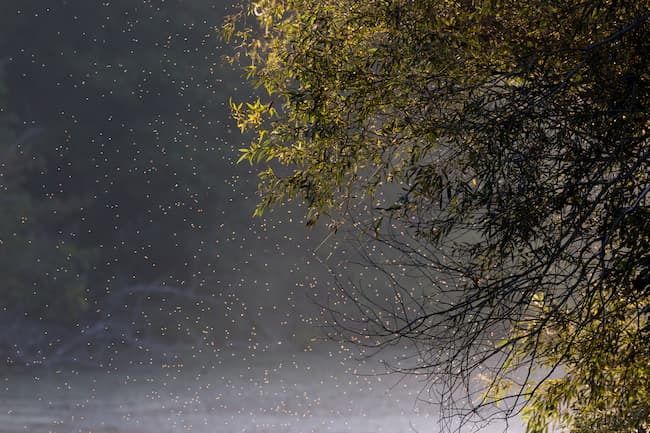
Midges fly in swarms that can contain anything from thousands, to millions, of members. A swarm of midges can result in thousands of bites doled out in a single hour.
Once a midge finds a source of blood it naturally produces pheromones that attract other midges to come and join the feast.
Midges in Scotland do have some natural predators (during all life stages), including spiders, fish, birds, beetles, dragonflies, bats and even the occasional insectivorous plant, but they're not a major source of food for any of these.
Midge larvae are probably consumed by predators in greater number than adult midges are, and fulfil some important roles in the ecosystem of Scotland's bodies of fresh water.
Perhaps surprising given how many midges there are in Scotland, but again perhaps not given how tiny they are.
Some research in the scientific community theorizes that the Scottish midge population has exploded over time and continues to do so, as a result of ongoing deforestation which leaves increasingly large areas of land without trees.
This has led to these areas now being covered with wet soil... the midges natural environment and favorite breeding ground.
It's not only humans who are the victims of the sheer bloodthirstiness and determination of the midges in Scotland, Scottish tourist industry also suffers. In 2016 it was estimated that it cost Scotland almost £270 million in lost revenue.
Scotland's midges also affects their forestry industry as, according to the Forestry Authority, approx. 20% of working days are lost in the summer due to the impact of midge swarms on their workers. Construction workers and other outdoor occupations can also be affected.
Scottish midges are small but they're mighty for sure!
Midges in Scotland FAQ
Anyone who hasn't grown up, or lived for long, in Scotland might not be aware of just how much of a troublemaker the Scottish midge can be.
If you're planning on visiting Scotland it might be a good idea to 'know thine enemy' and the answers to these frequently asked questions about Scottish midges will help you be prepared, and prevent the little creatures from making a dent in the enjoyment of your vacation or trip.
What are the worst places for midges in Scotland?
Midges are most common in the Highlands of Scotland (particularly the western Highlands), along the north and west coasts of Scotland, and on the islands off the northwest coast.
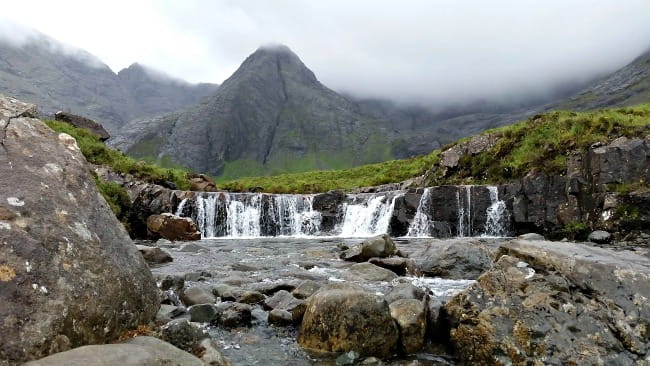
Studies have shown that midges are generally active in areas that get more than 49" inches of rain per year. As the Scottish Highlands routinely see over 120" annually, it's not surprising that the Highland Midge is so prevalent.
However, it's also worth mentioning that midges prefer lower elevations and are rarely active at elevations of over 1500ft. Midges tend to stay fairly close to their breeding sites and their food source (primarily cattle and deer), are more active within a half-mile radius of those areas.
Optimal breeding sites are in areas that tend to get a lot of rain and have consistently damp, acidic soil that is protected by moss, bracken, reeds, ferns etc. The wetter the soil the better, so bogs, marshes, lakeshores, river banks, glens and lower lying areas are prime midge habitat.
Some very popular tourist areas such as the Great Glen, including Glen Coe and Fort William areas, tend to be hot spots for the Scottish midge population. L
och Lomond and the Trossachs National Park is also highly likely to be populated with midges, often heavily, and camping there is probably not your best bet during the summer months.
Are there areas of Scotland which don't have midges?
Although there are no guarantees of midge-free Scottish locations during the summer months, certain areas are definitely less likely to be affected.
Scottish midges tend to be much less numerous on the east coast, and in the southern part of Scotland.
Locations that are attractive to tourists and relatively midge free include those around Inverness, Aberdeen, Dundee and Edinburgh, the Loch Ness area and the Cairngorms National Park.
Camping in the rural areas down this east coast swathe is do-able and midges shouldn't generally be much of a problem.
The manufacturers website for Smidge insect repellent has a Scottish Midge Forecast that is active from Spring through Fall when midges are at their most active.
You can use it to see where the annoying little bloodsuckers are at their worst, and at their best, which is very helpful when you're planning to be out and about.
When you're at the planning stage of a trip, take into account the midge population and the general annual rainfall for the area you're going to visit.
Both those things factor in to how many midges there are likely to be.
When is Scottish midge season?
You're most likely to come across midges in Scotland from late Spring through early Fall.
The midge season in Scotland generally extends from May through September, but major changes in weather (eg early winter weather) can affect that slightly.

The mid summer months of July and August are peak midge season in Scotland, but it starts to ramp up in early summer from June onwards.
The number of midges can vary somewhat from one year to another mostly dependent on weather conditions.
The summer of 2022 was unusually warm and dry in Scotland which had a noticeable impact on midge numbers as the weather considerably reduced the second peak of midge emergence which happens towards the end of July.
What time of day are Scottish midges most active?
Midges love the early morning, and in the evening, so dawn and dusk are the worst time of day when it comes to being attacked by Scottish midges.
Midday is the most midge-free time, so I'd suggest the best times to be out and about in midge season is from approx. 11:00am until about 2:00pm.
If it's a sunny day so much the better because midges don't like bright light and aren't out and about in numbers when it's sunny.
Conversely, cloudy, humid days can be pretty midge-y at all times.
Hot weather conditions and/or a wind speed of over 7mph can help keep the little troublemakers at bay too.
What is the Scottish midge life cycle?
Midges in Scotland have a four-stage life cycle (eggs, larvae, pupal, adults) which includes dormant and active phases, and generally lasts around twenty to thirty days.
Approximately five days after being fertilized, female midges lay their eggs in wet or moist areas, either above or below the waterline. Female Scottish midges often lay somewhere between fifty and one hundred eggs at a time, and have the ability to lay three batches of eggs over their lifespan, which is approximately one month.
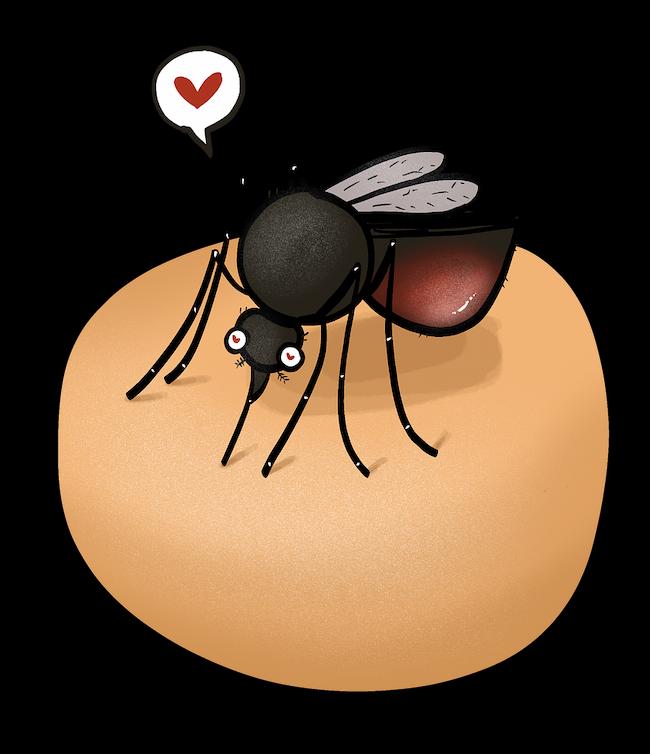
The eggs laid by female midges in Scotland generally hatch within a day or two. When the eggs hatch they are then considered larvae.
Midge larvae are tiny little worm-like creatures which continue to hang out in the cool, wet soil or on or below the surface of water sources, eventually hunkering down in the damp conditions to pass the cold winter months.
The following year, warming temperatures towards the end of Spring triggers the larvae to enter the pupal stage, which lasts only a couple of days and results in the transformation of the worm-like larvae into the winged, adult midge and the emergence of adults into the environment.
The adult female midge is born with the ability to lay their first batch of eggs without needing to feed (on blood) first. After that they need a blood meal after being fertilized in order to lay more batches of eggs.
The entire life cycle of the Scottish midge is generally around ten months from egg to adult midge, and this includes the time the larvae spend underground over the winter months.
But, the very first round of eggs laid by the female midges in Scotland (in May or early summer) may get through the larval and pupal stages and become adult midges within a single 'midge season' (which lasts from approx. May through September).
You can get a little bit more of the science, and details, behind the midge's life cycle HERE
What are midge bites like?
Although you don't have to worry about catching any nasty diseases from the midges in Scotland, and the bites don't really hurt, they are likely to be very itchy and annoying.
Many people are sensitive enough to midge bites (they're actually sensitive to the midge's saliva) to react with swollen, red, hot welts where they've been bitten.
If you're in the USA or Canada you will likely be very familiar with this reaction, as mosquito bites cause the same issues.
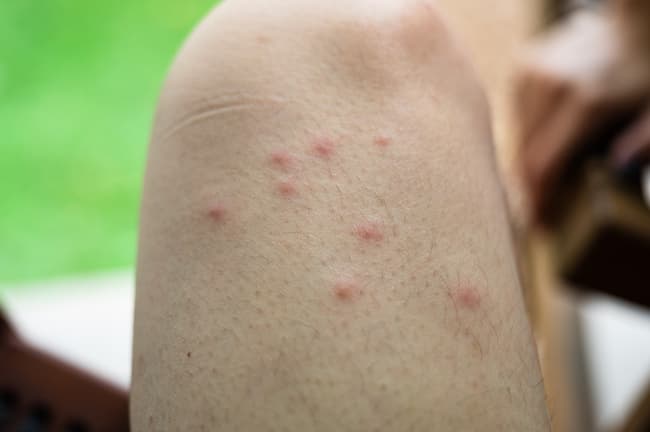
Occasionally these welts can resemble fluid-filled blisters and cause localized swelling.
Again, as with mosquitoes, it seems that some people are more attractive to, and sensitive to, mosquitoes and their bites.
Although there's no clear proof or statistics that can tell us exactly why that is (yet), a type of chemical in the human body called ketones may be part of the puzzle.
Other things such as body temperature, diet, blood sugar levels etc. may also play a role.
But this isn't any consolation for anyone who seems to be a midge-magnet (or a mosquito-magnet for that matter), I am one of those people so I speak from personal experience!
How do I treat Scottish midge bites?
If you get bitten by midges in Scotland there are lots of things you can do to help alleviate the itching involved.
One of the most popular ways is to use an over-the-counter antihistamine cream or gel (like the Benadryl products) or a cream containing hydrocortisone (like Cortizone or similar). These will reduce the inflammation and hopefully lessen the allergic-type response.
Home remedies for bites and stings such as putting a paste of baking soda and water on the bites, or taking a cool bath with some baking soda in the water can reduce itching.
As someone who reacts pretty dramatically to mosquito, midge and other insect bites I've found that holding an ice pack over the bitten area as soon as possible can significantly reduce subsequent swelling and itching. If you don't have an ice pack handy (and if you're out and about it's unlikely you will) try rubbing ice over it, or wrapping some ice cubes in a damp paper towel, t-shirt of piece of cloth and use that instead.
Try to avoid scratching at the bites/welts as if you break the skin it can sometimes let in bacteria which lead to infection. Not to mention, scratching them just pushes the irritating substances from the midge saliva deeper into your skin/tissue and make the itching worse.
Although they're very annoying, midge bites usually get better within a few days even if you don't treat them at all.
What is the best Scottish midge repellent?
Finding out the best way to keep Scottish midges away from you, and which are the best repellants to use for midges in Scotland are key questions in most peoples minds when spending time in northern Scotland during the summer months.
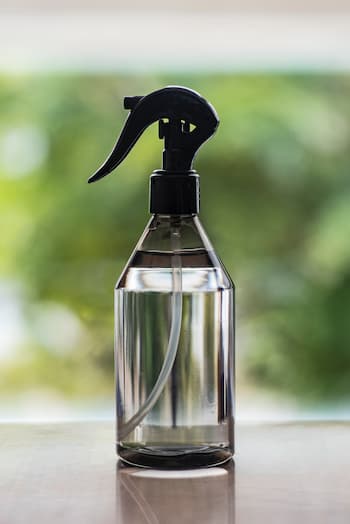
There are a few things we can do to help offset some of the natural bodily compositions that attract midges. These include using insect repellents which contain ingredients and scents that midges and other flying creatures dislike.
Some natural products that have a similar effect are certain essential oils such as tea tree, eucalyptus, lavender and lemongrass.
There is also a natural product made using Bog Myrtle which grows in the Highlands and is said to be a natural insect repellent (you can find this locally and on Amazon.co.uk as The Wee Midgie/Myrtle Body Butter).
Other types of Scottish midge repellent include the all-natural Beastie BE Gone which contains a blend of natural essential oils and the midge-specific, DEET-free, 'Smidge' which contains synthetic Picaridin/Saltidin to repel insects as well as natural ingredients such as chamomile, orange and limonene.
Both Smidge and Beastie BE Gone can also be found on Amazon.co.uk and locally in the UK.
Any insect repellent which contains Picaridin is effective against a variety of different biting bugs, including midges, mosquitoes and ticks. There are many to choose from and can be found in the US including Sawyer Picardin insect repellent, Ranger Ready insect repellent, Off! Clean Feel insect repellent and more.
Although not specifically formulated for midges they work well to repel them. Most biting flies and insects are deterred by the same scents or chemicals.
Other, more generic, insect repellents can also be used to protect against midges in Scotland.
Anything containing DEET or Picaridin/Saltidin are usually the most efficient, but there are many natural brands and options available too.
If you're planning on being outdoors around midges for extended periods of time (such as when hiking), an insect head-net or hood can be a great addition to your midge-repelling approach.
The Smidge super lightweight head net or the Benvo mosquito netting hood are good choices. These are more comfortable if worn over a hat or you can opt for a head net with a built-in hat to protect from sunshine (or more likely rain!).
What keeps midges in Scotland away from you?
Midges (like other biting insects including flies and mosquitoes) are attracted by the carbon dioxide, heat, chemicals and odors produced by warm blooded creatures like human beings.
Of course it also includes wildlife and other animals, and favorite targets of the Highland midge are deer and cattle. Sheep too if deer or cattle are in short supply.
You can make yourself less attractive to midges in Scotland by wearing light colored clothing (research shows midges are particularly attracted to dark-colored objects that are moving so dark clothing can make you a midge-target).
Motion is also good because midges are more likely to surround and attack you if you're standing, or sitting, still. While you're moving you'll be more midge-free. If you're cycling it's even better because you're creating your own wind, which midges simply can't fly in.
It also helps to make sure as much of your skin is covered as possible. Long sleeves and long pants work much better than shorts and a t-shirt, and Scottish weather isn't generally very hot even in summer so this is possible to do. A midge hood/head net as discussed above can be a plus.
You can also buy a full-body midge net which might seem like overkill, but can actually be very worthwhile if you're deep in Scottish midge territory.
Midges in Scotland are extremely small, and are easily able to get inside your clothes, creating havoc, so tuck your pants legs into boots and make sure the cuffs/collar of your shirt is as tight fitting as possible.
If you are stopping to eat, or camp, in an area which is prone to midges you're going to be sitting ducks, and will need to up your game. Pick a sunny spot, preferably in direct sunlight during the daytime as midges aren't fans of bright sun.
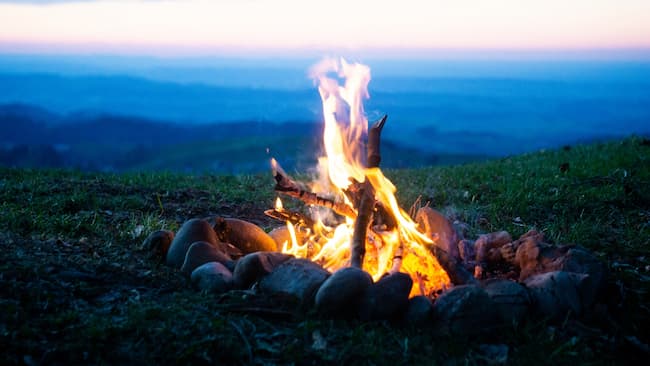
Campfire smoke and citronella candles or scented products can help keep midges at bay in the evening, at least partially. But remember to be aware of the fire danger of flames to ground cover.
Traps that are specifically designed to attract, and kill, flying biting insects such as midges or mosquitoes can also be effective. They usually use a combination of Carbon Dioxide and blue light to attract, and then trap/kill the little flying beasties.
There are lots of options, and sizes, to choose from and they can be found on Amazon, at hardware or sporting good stores and many others places.
Scottish midge v mosquito
There are quite a few differences between midges in Scotland (and elsewhere) and mosquitoes. There are also some similarities.
Differences between a Scottish midge and a mosquito:
When we compare them, the first and most noticeable difference is in their size.
A midge is a tiny insect, measuring between 1 and 3 mm in size and weighing approx. 1/8000 of a gram , whereas a mosquito is usually between 3 and 6 mm in size and weighs approx. 5 grams.
Another important difference is that the midges of Scotland don't carry or transmit diseases, such as Lyme Disease, to humans the way mosquitoes often do. However some biting midges can cause illness in birds.
Also, midges can't fly in winds over 5 mph while mosquitoes can remain accurate and airborne in winds of up to approx 10mph.
While midges are not fans of hot weather mosquitoes thrive in the heat.
Similarities between a Scottish midge and a mosquito:
Only female midges bite, the same can be said about mosquitoes.
Their bite can cause an allergic-type reaction resulting in intense itching and welts around the bite itself
They both suck blood from their victims and their bodies can become swollen and red in color after a blood meal
Both like warm, humid or damp weather and prefer to be out during dawn or dusk.
Both Scottish midges and mosquitoes are active during the summer months, and neither adult midges or mosquitoes can survive in cold weather, although their lava can if well protected.
You may also like:
- Scotland's Hidden Gems
- Scottish Highland Games
- Scottish Castles
- Northern Lights in Scotland
- Scottish Loch Monsters
- Home
- Facts About Scotland
- Midges in Scotland